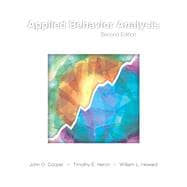
Note: Supplemental materials are not guaranteed with Rental or Used book purchases.
Purchase Benefits
What is included with this book?
| I | |
| Definition and Characteristics of Applied Behavior Analysis | |
| Some Basic Characteristics of Science | |
| Defining Characteristics of Applied Behavior Analysis | |
| A Brief Outline of the Development of Applied Behavior Analysis | |
| Definition of Applied Behavior Analysis | |
| Summary | |
| Basic Concepts | |
| Behavior | |
| Environment | |
| Respondent Behavior and Respondent Conditioning | |
| Operant Behavior and Operant Conditioning | |
| Basic Principles and Applied Procedures | |
| Kinds of Stimuli That Reinforce and Punish | |
| The Three-Term Contingency | |
| The Complexity of Human Behavior | |
| Obstacles to Control of Behavior in Applied Settings | |
| Summary | |
| Selection, Definition, and Measurement of Behavior Change Target | |
| Selecting and Defining Target Behavior | |
| Role of Assessment in Applied Behavior Analysis | |
| Methods and Issues in Gathering Behavioral Assessment Data | |
| Considerations in Selecting a Target Behavior | |
| Prioritizing Possible Target Behaviors | |
| Defining the Target Behavior | |
| Setting Criteria for Behavior Change | |
| Summary | |
| Measuring and Recording Behavior | |
| Direct Measurement of Permanent Products | |
| Direct Observation Recording | |
| Reporting Data Collected | |
| Summary | |
| Planning and Directing Observational Procedures | |
| Scheduling Continuous and Sample Observations | |
| Selecting Times for Observation | |
| Establishing the Duration of Observation Sessions | |
| Planning Sampling Procedures | |
| Observation Codes | |
| Interobserver Agreement | |
| Establishing Interobserver Agreement | |
| Considerations in Using Interobserver Agreement | |
| Sources of Influence on the Agreement and Accuracy of Measurement | |
| Summary | |
| Evaluation and Analysis of Behavior Change | |
| Production and Interpretation of Graphic Data Displays | |
| Benefits of Graphic Display of Behavioral Data | |
| Line Graphs | |
| Other Types of Graphs Used in Applied Behavior Analysis | |
| How to Construct Graphs | |
| How to Interpret Graphs | |
| Summary | |
| Introduction to Analysis | |
| The Scientific Examination of Behavior: Some Basic Conceptions and Assumptions | |
| Components of Experimental Design | |
| Baseline Data | |
| Baseline Logic | |
| Summary | |
| Reversal and Alternating Treatments Design | |
| Reversal Designs | |
| Alternating Treatment Design | |
| Summary | |
| Multiple Baseline and Changing Criterion Designs | |
| Multiple Baseline Design | |
| Changing Criterion Design | |
| Summary | |
| Planning, Replicating, and Evaluating Research in Applied Behavior Analysis | |
| Planning Research in Applied Behavior Analysis | |
| Internal Validity: Controlling Potential Sources of Confounding in an Experimental Design | |
| External Validity: The Role of Replication in Applied Behavior Analysis | |
| Evaluating Research in Applied Behavior | |
| Analysis | |
| Summary | |
| Increasing Existing Behavior | |
| Operant Reinforcement | |
| The Role of Genetic Inheritance | |
| Definition of Operant Reinforcement | |
| Positive Reinforcement | |
| Negative Reinforcement | |
| Types of Potential Reinforcers | |
| Selecting Potential Reinforcers | |
| Factors Influencing the Effectiveness of Reinforcement | |
| Guidelines for Using Reinforcement | |
| Summary.12. Schedules of Reinforcement | |
| Use of Continuous and Intermittent Reinforcement | |
| Basic Intermittent Schedules of Reinforcement | |
| Ratio Schedules | |
| Interval Schedules | |
| Complex Schedules of Reinforcement | |
| Adjunctive Behavior | |
| Summary | |
| Stimulus Control | |
| Stimulus Control | |
| Antecedent Stimuli | |
| Stimulus Generalization | |
| Development of Stimulus Control with Differential Reinforcement | |
| Concept Formation | |
| Factors Affecting the Development of Stimulus Control | |
| Response and Stimulus Prompts | |
| Transfer of Stimulus Control | |
| Discriminative and Motivational Functions of Stimuli | |
| Summary | |
| Developing New Behavior | |
| Behavioral ShapingDefinition and Illustration of Behavior Shaping | |
| Behavioral Shaping Across and Within Different Response Topographies | |
| Increasing the Efficiency of Behavioral Shaping | |
| Guidelines for Selecting and Implementing Behavioral Shaping | |
| Summary | |
| Behavioral Chai | |
| Table of Contents provided by Publisher. All Rights Reserved. |
The New copy of this book will include any supplemental materials advertised. Please check the title of the book to determine if it should include any access cards, study guides, lab manuals, CDs, etc.
The Used, Rental and eBook copies of this book are not guaranteed to include any supplemental materials. Typically, only the book itself is included. This is true even if the title states it includes any access cards, study guides, lab manuals, CDs, etc.